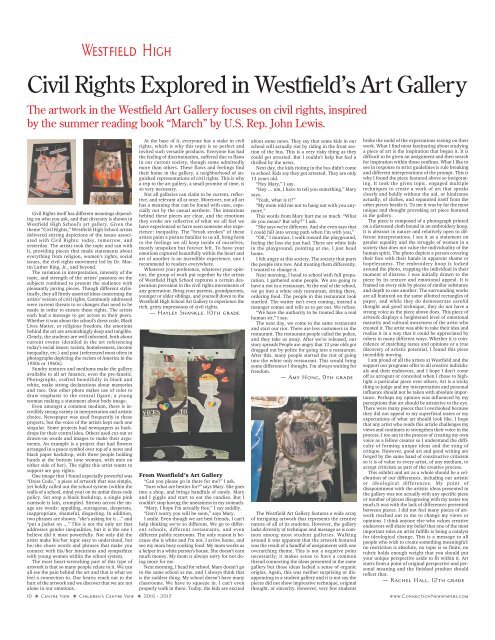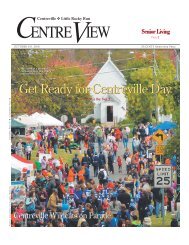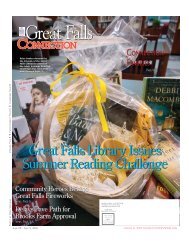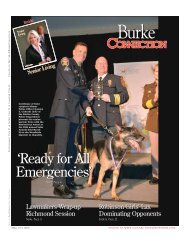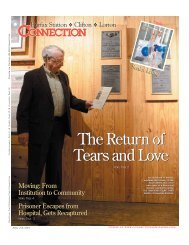Children’s Centre View 2016
Centreview
Centreview
Create successful ePaper yourself
Turn your PDF publications into a flip-book with our unique Google optimized e-Paper software.
Westfield High<br />
Civil Rights Explored in Westfield’s Art Gallery<br />
The artwork in the Westfield Art Gallery focuses on civil rights, inspired<br />
by the summer reading book “March” by U.S. Rep. John Lewis.<br />
Civil Rights itself has different meanings depending<br />
on who you ask, and that diversity is shown in<br />
Westfield High School’s art gallery. Given the<br />
theme “Civil Rights,” Westfield High School artists<br />
delivered stirring depictions of the issues associated<br />
with Civil Rights: today, tomorrow, and<br />
yesterday. The artists took the topic and ran with<br />
it, providing pieces that made statements about<br />
everything from religion, women’s rights, social<br />
issues, the civil rights movement led by Dr. Martin<br />
Luther King, Jr., and beyond.<br />
The variation in interpretation, intensity of the<br />
topic, and strength of the artists’ passions on the<br />
subjects combined to present the audience with<br />
pleasantly jarring pieces. Though different stylistically,<br />
they all firmly asserted ideas concerning the<br />
artists’ version of civil rights. Commonly addressed<br />
were current threats to or changes that need to be<br />
made in order to ensure these rights. The artists<br />
each had a message to get across to their peers.<br />
Whether it was about the school’s dress code, Black<br />
Lives Matter, or religious freedom, the emotions<br />
behind the art are astonishingly deep and tangible.<br />
Clearly, the students are well informed, both about<br />
current events (detailed in the art referencing<br />
today’s social issues: racism, homelessness, income<br />
inequality, etc.) and past (referenced most often in<br />
photographs depicting the racism of America in the<br />
1950s or 1960s).<br />
Sundry textures and mediums make the gallery<br />
available to all art fanatics, even the pre-fanatic.<br />
Photographs, crafted beautifully in black and<br />
white, make strong declarations about memories<br />
and race. One other photo makes use of color to<br />
draw emphasis to the central figure, a young<br />
woman making a statement about body image.<br />
Even amongst a common medium, there is incredibly<br />
strong variety in interpretation and artistic<br />
choice. Newspaper was used frequently in these<br />
projects, but the voice of the artists kept each one<br />
singular. Some projects had newspapers as backdrops<br />
for their central idea. Others used cut-out or<br />
drawn-on words and images to make their arguments.<br />
An example is a project that had flowers<br />
arranged in a peace symbol over top of a news and<br />
black paper backdrop, with three people holding<br />
hands at the bottom (one woman, with men on<br />
either side of her). The rights this artist wants to<br />
support are gay rights.<br />
One image that I found especially powerful was<br />
“Dress Code,” a piece of artwork that was simple,<br />
yet boldly called out the school system (within the<br />
walls of a school, mind you) on its unfair dress code<br />
policy. Set atop a black backdrop, a single pink<br />
camisole is lain, crumpled. Strewn across the image<br />
are words: appalling, outrageous, desperate,<br />
inappropriate, shameful, disgusting. In addition,<br />
two phrases are shown: “she’s asking for it ...” and<br />
“put a jacket on ...” This is not the only art that<br />
addresses gender inequalities, but it is the one I<br />
believe did it most powerfully. Not only did the<br />
artist make his/her topic easy to understand, but<br />
he/she chose words and phrases that make you<br />
connect with his/her intentions and sympathize<br />
with young women within the school system.<br />
The most heart-wrenching part of this type of<br />
artwork is that so many people relate to it. We can<br />
all see the pain behind the art and that is what we<br />
feel a connection to. Our hearts reach out to the<br />
hurt of the artwork and we discover that we are not<br />
alone in our emotions.<br />
At the base of it, everyone has a stake in civil<br />
rights, which is why this topic is so perfect and<br />
invited such versatile products. Everyone has had<br />
the feeling of discrimination, suffered due to flaws<br />
in our current society, though some admittedly<br />
more than others. These flaws and feelings find<br />
their home in the gallery, a neighborhood of anguished<br />
representations of civil rights. This is why<br />
a trip to the art gallery, a small promise of time, is<br />
so very necessary.<br />
Not all galleries can claim to be current, reflective,<br />
and relevant all at once. Moreover, not all art<br />
has a meaning that can be found with ease, especially<br />
not by the casual aesthete. The intentions<br />
behind these pieces are clear, and the emotions<br />
they evoke are reflective of what we all feel we<br />
have experienced or have seen someone else experience:<br />
inequality. The “brush strokes” of these<br />
artists paint a picture familiar to us all, bring form<br />
to the feelings we all keep inside of ourselves,<br />
mostly unspoken but forever felt. To have your<br />
emotions captured beautifully within the heart and<br />
art of another is an incredible experience, one I<br />
recommend to readers everywhere.<br />
Whatever your preference, whatever your opinion,<br />
the group of work put together by the artists<br />
of Westfield High School captures a certain desperation<br />
prevalent in the civil rights movements of<br />
any generation. Bring your parents, grandparents,<br />
younger or older siblings, and yourself down to the<br />
Westfield High School Art Gallery to experience the<br />
rich, gritty impressions of civil rights.<br />
— Hayley Shankle, 10th grade<br />
From Westfield’s Art Gallery<br />
“Can you please go in there for me?” I ask.<br />
“Sure what are besties for?” says Mary. She goes<br />
into a shop, and brings handfuls of candy. Mary<br />
and I giggle and start to eat the candies. But I<br />
couldn’t stop having the uneasiness in my stomach.<br />
“Mary, I hope I’m actually free,” I say saddily.<br />
“Don’t worry you will be soon,” says Mary.<br />
I smile. Even though we are best friends, I can’t<br />
help thinking we’re so different. We go to different<br />
schools, different restaurants, and even<br />
different public restrooms. The only reason is because<br />
she is white and I’m not. I arrive home, and<br />
see my mom busy cooking food. My mom works as<br />
a helper in a white person’s house. She doesn’t earn<br />
much money. My mom is always sorry for not doing<br />
more for me.<br />
Next morning, I head for school. Mary doesn’t go<br />
to the same school as me, and I always think that<br />
is the saddest thing. My school doesn’t have many<br />
classrooms. We have to squeeze in. I can’t even<br />
properly walk in there. Today, the kids are excited<br />
about some news. They say that some kids in our<br />
school will actually riot by riding in the front section<br />
of the bus. This is a very risky thing as they<br />
could get arrested. But I couldn’t help but feel a<br />
thrilled by the news.<br />
Next day, the kids rioting in the bus didn’t come<br />
to school. Kids say they got arrested. They are only<br />
13 years old.<br />
“Hey Mary,” I say.<br />
“Hey … um, I have to tell you something,” Mary<br />
says.<br />
“Yeah, what is it?”<br />
“My mom told me not to hang out with you anymore.”<br />
This words from Mary hurt me so much. “What<br />
do you mean? But why?” I ask.<br />
“She says we’re different. And she even says that<br />
I could fall into wrong path when I’m with you,”<br />
“OK,” I murmur. I walk toward the playground,<br />
feeling the loss she just had. There are white kids<br />
in the playground, pointing at me. I just head<br />
home.<br />
I felt angry at this society. The society that parts<br />
the people into two. And treating them differently.<br />
I wanted to change it.<br />
Next morning, I head to school with full preparation.<br />
I gathered some people. We are going to<br />
have a riot in a restaurant. At the end of the school,<br />
we go into a white only restaurant, sitting there,<br />
ordering food. The people in this restaurant look<br />
startled. The waiter isn’t even coming, instead a<br />
manager comes and tells us to get out. We refuse.<br />
“We have the authority to be treated like a real<br />
human sir,” I say.<br />
The next day, we come to the same restaurant<br />
and start our riot. There are less customers in the<br />
restaurant. The restaurant people called the police,<br />
and they take us away. After we’re released, our<br />
story spreads People are angry that 13 year olds got<br />
dragged out by police for going into a restaurant.<br />
After this, many people started the riot of going<br />
into the white only restaurant. This would bring<br />
some differences I thought. I’m always waiting for<br />
freedom.<br />
— Amy Hong, 9th grade<br />
The Westfield Art Gallery features a wide array<br />
of intriguing artwork that represents the creative<br />
nature of all of its students. However, the gallery<br />
lacks diversity of technique and message as is common<br />
among most student galleries. Walking<br />
around it was apparent that the artwork featured<br />
was the result of a handful of assignments with one<br />
overarching theme. This is not a negative point<br />
necessarily; it makes sense to have a common<br />
thread connecting the ideas presented in the same<br />
gallery but those ideas lacked a sense of organic<br />
origins. Again, this was neither surprising or disappointing<br />
in a student gallery and it is not say the<br />
pieces did not show impressive technique, original<br />
thought, or sincerity. However, very few students<br />
broke the mold of the expectations resting on their<br />
work. What I find most fascinating about studying<br />
a piece of art is the inspiration that began it. It is<br />
difficult to be given an assignment and then search<br />
for inspiration within those confines. What I like to<br />
see in response to strict guidelines is rule breaking<br />
and different interpretations of the prompt. This is<br />
why I found the piece featured above so invigorating.<br />
It took the given topic, engaged multiple<br />
techniques to create a work of art that speaks<br />
clearly and boldly without the aid, or hindrance<br />
actually, of cliches, and separated itself from the<br />
other pieces beside it. To me it was by far the most<br />
unique and thought provoking art piece featured<br />
in the gallery.<br />
The piece is composed of a photograph printed<br />
on a distressed cloth bound in an embroidery hoop.<br />
It is abstract in nature and relatively open to different<br />
interpretations. I see it as a statement on<br />
gender equality and the struggle of woman in a<br />
society that does not value the individuality of the<br />
human spirit. The photo depicts a person covering<br />
their face with their hands in apparent shame or<br />
hopelessness. The embroidery hoop is locked<br />
around the photo, trapping the individual in their<br />
moment of distress. I was initially drawn to the<br />
piece by its texture and emotional appeal. It is<br />
framed on every side by pieces of similar substance<br />
and depth to one another. The surrounding works<br />
are all featured on the same allotted rectangles of<br />
paper, and while they do demonstrate careful<br />
thought and good technique, they do not have a<br />
strong voice as the piece above does. This piece of<br />
artwork displays a heightened level of emotional<br />
maturity and cultural awareness of the artist who<br />
created it. The artist was able to take their idea and<br />
realize it in a way that it could be appreciated by<br />
others in many different ways. Whether it is coincidence<br />
of matching tastes and opinions or a true<br />
discovery of artistic potential, I found this piece<br />
incredibly moving.<br />
I am proud of all the artists at Westfield and the<br />
support our programs offer to all creative individuals<br />
and their endeavors, and I hope I don’t come<br />
off as arrogant or conceited when I chose to highlight<br />
a particular piece over others. Art is a tricky<br />
thing to judge and my interpretation and personal<br />
influence should not be taken with absolute importance.<br />
Perhaps my opinion was influenced by my<br />
perceptions that art should be attractive to the eye.<br />
There were many pieces that I overlooked because<br />
they did not appeal to my superficial tastes or my<br />
expectations of what art should look like. I hope<br />
that any artist who reads this article challenges my<br />
views and continues to strengthen their voice in the<br />
process. I too am in the process of creating my own<br />
voice as a fellow creator so I understand the difficulty<br />
of forming unique ideas and the sting of<br />
critique. However, good art and good writing are<br />
forged by the same hand of constructive criticism<br />
so it is of value to every artist, of any medium, to<br />
accept criticism as part of the creative process.<br />
This exhibit and art as a whole should be a celebration<br />
of our differences, including our artistic<br />
or ideological differences. My point of<br />
disapointment with the artistic ideas presented in<br />
the gallery was not actually with any specific piece<br />
or number of pieces disagreeing with my tastes too<br />
much.It was with the lack of differences presented<br />
between pieces. I did not feel many pieces of artwork<br />
reached out to me to change my views or<br />
opinions. I think anyone else who values creative<br />
endeavors will share my belief that one of the most<br />
important roles an artist fulfills is being a catalyst<br />
for ideological change. This is a message to all<br />
people who wish to create something meaningful:<br />
no restriction is absolute, no topic is so finite, no<br />
rubric holds enough weight that you should put<br />
your unique perspective aside to fit within it. Art<br />
starts from a point of original perspective and personal<br />
meaning and the finished product should<br />
reflect that.<br />
— Rachel Hall, 12th grade<br />
10 ❖ <strong>Centre</strong> <strong>View</strong> ❖ <strong>Children’s</strong> <strong>Centre</strong> <strong>View</strong> ❖ <strong>2016</strong> - 2017 www.ConnectionNewspapers.com


